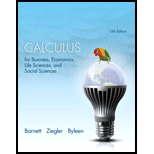
Concept explainers
Matched Problem 6 Repeat Example 6 if C′(t) = 1 and
EXAMPLE 6 Useful Life An amusement company maintains records for each video game installed in an arcade. Suppose that C(t) and R(t) represent the total accumulated costs and revenues (in thousands of dollars), respectively, t years after a particular game has been installed. Suppose also that
The value of t for which C′ (t) = R′(t) is called the useful life of the game.
- (A) Find the useful life of the game, to the nearest year.
- (B) Find the total profit accumulated during the useful life of the game.
Want to see the full answer?
Check out a sample textbook solution
Chapter 5 Solutions
Calculus for Business Economics Life Sciences and Social Sciences Plus NEW
- Find an nfa that accepts the language L(aa (a + b)). Create and test the NFA in Jflap. Test the strings: aab, ab, aaaa, aaaab, baab, aa, abbbb, a, b, 1. Submit the Jflap diagram and the Jflap test cases. 4. Find an nfa that accepts the language L (aa* (a+b)).arrow_forwardCVE, AVM, AC, ¬SA¬ME A Fitch Style proof for this argumentarrow_forward13:26 ... ← Robert F. Blitzer - Thinkin... 0,04 61 KB/d 目 polygons to create a fraudulent tessellation with discrepancies that are too subtle for the eye to notice. In Exercises 45-46, you will use mathematics, not your eyes, to observe the irregularities. B A 45. Find the sum of the angle measures at vertex A. Then explain why the tessellation is a fake. 46. Find the sum of the angle measures at vertex B. Then explain why the tessellation is a fake. =et at If se Fic SECTION 10.3 Polygons, Perimeter, and Tessellations 645 61. I find it helpful to think of a polygon's perimeter as the length of its boundary. 62. If a polygon is not regular, I can determine the sum of the measures of its angles, but not the measure of any one of its angles. 63. I used floor tiles in the shape of regular pentagons to completely cover my kitchen floor. In Exercises 64-65, write an algebraic expression that represents the perimeter of the figure shown. is be 64. le a b C 2/ If se nyarrow_forward
- Algebra & Trigonometry with Analytic GeometryAlgebraISBN:9781133382119Author:SwokowskiPublisher:Cengage
 College Algebra (MindTap Course List)AlgebraISBN:9781305652231Author:R. David Gustafson, Jeff HughesPublisher:Cengage Learning
College Algebra (MindTap Course List)AlgebraISBN:9781305652231Author:R. David Gustafson, Jeff HughesPublisher:Cengage Learning Algebra and Trigonometry (MindTap Course List)AlgebraISBN:9781305071742Author:James Stewart, Lothar Redlin, Saleem WatsonPublisher:Cengage Learning
Algebra and Trigonometry (MindTap Course List)AlgebraISBN:9781305071742Author:James Stewart, Lothar Redlin, Saleem WatsonPublisher:Cengage Learning 
 Linear Algebra: A Modern IntroductionAlgebraISBN:9781285463247Author:David PoolePublisher:Cengage Learning
Linear Algebra: A Modern IntroductionAlgebraISBN:9781285463247Author:David PoolePublisher:Cengage Learning College AlgebraAlgebraISBN:9781305115545Author:James Stewart, Lothar Redlin, Saleem WatsonPublisher:Cengage Learning
College AlgebraAlgebraISBN:9781305115545Author:James Stewart, Lothar Redlin, Saleem WatsonPublisher:Cengage Learning





